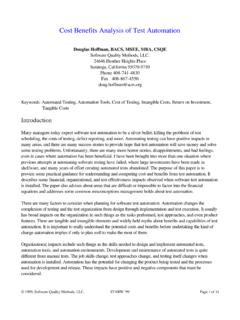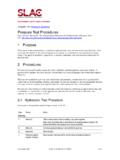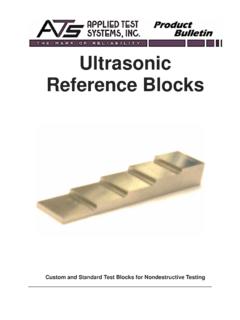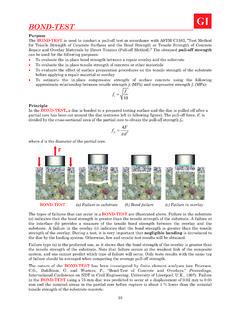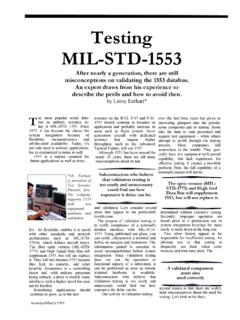Transcription of Test Automation Architectures: Planning for Test Automation
1 Copyright 1999, Software Quality Methods, Automation Architectures: Planning for Test AutomationDouglas HoffmanSoftware Quality Methods, Heather Heights PlaceSaratoga, California 95070-9710 Phone 408-741-4830 Fax Automated Testing, Test Oracles, Automation architecture , Test ModelsAbstractDesigning a practical test Automation architecture provides a solid foundation for a successfulautomation effort. This paper describes key elements of automated testing that need to beconsidered, models for testing that can be used for designing a test Automation architecture , andconsiderations for successfully combining the elements to form an automated test paper first develops a general framework for discussion of software testing and testautomation. This includes a definition of test Automation , a model for software tests , and adiscussion of test oracles.
2 The remainder of the paper focuses on using the framework to plan fora test Automation architecture that addresses the requirements for the specific software under test(SUT).IntroductionMany managers, especially those outside of software quality, have a simplistic view of testautomation. Test Automation is more than a set of tests run to generate apparent results. Itincludes designing testware, implementing automated test cases, and monitoring and interpretinga broad range of results. Automation by simply running test cases without human interactiondoesn t provide interesting test exercises. We must know how the SUT reacts before the exercisecan become a useful test. In fact, automating the running of tests generates data much morequickly than manual testing, and therefore there is more data to sift through before knowing howthe SUT responded during the tests .
3 This requires more time from testers and can result in lesseffective tests . Elements besides the SUT output can also be directly effected by the SUT, andthese need to be evaluated in automated tests as for effective test Automation include several factors beyond having test cases andautomated mechanisms for running them. Organization for the test cases is needed so we canselect and understand what test run, When problems are encountered we need to be able to runselected subsets or start in the middle of the tests . Automated test execution is what most testersthink of when thinking about test Automation . But, test results need to be captured and expectedTest Automation ArchitecturesInternational Quality Week 1999 Copyright 1999, Software Quality Methods, 2outcomes compared. To automate capture and comparison the data has to be machine readable,which is somewhat difficult for many classes of results including GUI displays, screennavigation, and program states.
4 Automated comparison of results is highly dependent on theform of information being compared. Filters often need to be made to compensate for Automation can only be successful when we keep in mind that testware in general, andparticularly automated testware, is easily made obsolete by changes in the SUT and architecture must take into consideration that changes will occur and be designed tominimize the impact of such Definition of Automated Software TestsManual testing can be described as a situation where a person initiates each test, interacts with it,and interprets, analyzes, and reports the results. Software testing is automated when there is amechanism for tester-free running of test cases. I generally call test cases automated when all ofthe following elements are present. If one or more elements are absent I consider the tests semi-automated.
5 (Which is often the most cost-effective.) Ability to run two or more specified test cases Ability to run a subset of all the automated test cases No intervention is needed after launching the tests Automatically sets-up and/or records the relevant test environment parameters Runs the test cases Captures the relevant results Compares actual with expected results and flags differences Analyzes and reports pass/fail for each test case and for the test runKey Factors in Automated TestingThe first step in Planning for test Automation is to identify and understand some key factors aboutthe SUT: Identify what software is to be tested, its specific components and features we want totest, and the environment surrounding the SUT. These factors are critical to the automationarchitecture. Additionally, understand the existing and available testware elements and tools fortesting and test Automation in the SUT s sometimes obvious, it is often enlightening to formally describe what is it we want totest and distinguish it from all other elements in the system.
6 It is also important to identify whatthings we think are outside the scope of our Automation or we don t intend to test. Several relatedapplications and utilities with different interfaces may comprise the SUT, possibly even runningin different environments. Early decisions on which components to include, which to exclude,and which features are most important can put definitive boundaries on the Automation tasks andsubstantially reduce their the SUT elements are identified the environment and interfaces must be considered. Forlarge or complex SUTs there are often multiple environments to consider and the core programsTest Automation ArchitecturesInternational Quality Week 1999 Copyright 1999, Software Quality Methods, 3to be tested may have several GUI and API interfaces. The immediate technical environment isimportant to Automation because it provides the facilities and constraints on the most practicalapproaches.
7 Multi-tasking, process communications, pipes, standard comparison utilities, etc.,mold the mechanics of the test Automation . Tools and utilities may be unique to one environmentor they may be available across platforms. Many tools and utilities that are available in multipleenvironments have incompatible interfaces, which can make porting of automated test cases asdifficult as using different tools in the different form of the data for input and results capture is also important. Inputs and results may bekeystrokes, data communication messages, pictures, sounds, digital device inputs or outputs,display information, etc. Comparison of binary data is different from characters, and sometimesthe data has both syntactic and semantic components that must be dealt with. ( , In a data basesearch, the order of record retrieval may vary but the same records should match the searchcriteria and the contents of each record should be the same.)
8 Another program s output may bepostscript listing, which can change substantially without changing the final printed form.)Utilities may run in different operating modes or systems from the core application. Creating aunified test Automation architecture is difficult when the SUT needs to be tested in multipleincompatible systems environments. Depending on the requirements in a given situation, aunified architecture may be most effective for the automated testing system or it may beadvantageous to employ multiple tools and mechanisms for the different is not necessary to have one Automation architecture that covers all the components. Testingcan succeed when the tester and Automation tools perform a useful test and draw properconclusions based on the results. Automation is valuable to augment the tester by performingtasks that are tedious or impossible for a human or are more cost effective to automate.
9 Differenttypes of tests are run at different times and not all related tests have to be run at one time. Thereis little advantage in a unified Automation architecture when there are substantially differentproducts or environments and very little common testware across them. Two simple automationengines are often easier to create and support than one overly complex scope of the planned Automation tasks also depends on the existing and available testwareelements and tools. The testware elements include all of the software, documentation, test cases,data, programs, and associated procedures needed for all the test activities. The tools includeoperating system utilities, SCM, test selection and control programs, comparison routines, etc.,that are employed to do the testing and Automation . Although availability and current use ofautomated tools does not necessitate that Automation be based on them, it is common for anautomation architecture to have a requirement to include existing testware.
10 (But, if the existingtestware and tools were really effective we would not need to develop a new automationarchitecture.) Whether to constrain possible architectures by demanding inclusion of existingtestware should be carefully considered, as it is always possible to continue to use existingautomated tests as they are without compromising more effective Automation the most cost-effective way of dealing with legacy tests is by gradually phasing themout as they require areas of test Automation require special attention. Results capture can be a huge task whenyou realize the world of possible results from running software. The actual results of running aTest Automation ArchitecturesInternational Quality Week 1999 Copyright 1999, Software Quality Methods, 4test are much more than viewing information on the screen.
